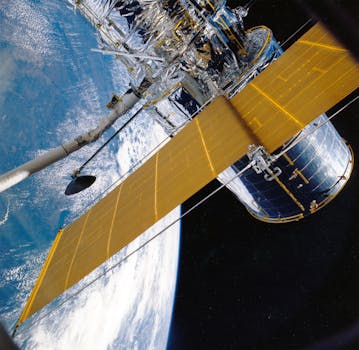From Geostationary to Low Earth Orbit: The Evolution of Satellite Telecommunications in 2023
The satellite telecommunications industry has undergone significant transformations in recent years, driven by advancements in technology and shifting market demands. This article delves into the evolution of satellite telecommunications, from geostationary to low earth orbit, and explores the current state of the industry in 2023.

From Geostationary to Low Earth Orbit: The Evolution of Satellite Telecommunications in 2023
Focus Keyword: Satellite Telecommunications. The satellite telecommunications industry has undergone significant transformations in recent years, driven by advancements in technology and shifting market demands. As we navigate the complexities of the digital age, it’s essential to understand the evolution of satellite telecommunications, from geostationary to low earth orbit, and explore the current state of the industry in 2023.
Satellite telecommunications have been a cornerstone of global communication systems for decades, providing critical connectivity to remote and underserved areas. The early days of satellite telecommunications were marked by the use of geostationary satellites, which orbit the Earth at an altitude of approximately 36,000 kilometers. These satellites offered a reliable and efficient means of transmitting data, voice, and video signals over long distances. However, they had limitations, including high latency and limited bandwidth.
The advent of low earth orbit (LEO) satellites has revolutionized the satellite telecommunications industry. LEO satellites operate at an altitude of around 160 to 2,000 kilometers, which enables them to offer lower latency and higher bandwidth compared to geostationary satellites. This has made LEO satellites an attractive option for a range of applications, including broadband internet, mobile connectivity, and Earth observation.
The Rise of Low Earth Orbit Satellites
The shift towards LEO satellites has been driven by advancements in technology, including the development of smaller, more efficient satellites and the use of advanced materials and propulsion systems. Companies such as SpaceX, OneWeb, and Amazon’s Kuiper Systems are at the forefront of this revolution, launching constellations of LEO satellites designed to provide global coverage and high-speed connectivity.
LEO satellites offer several advantages over geostationary satellites, including lower latency, higher bandwidth, and improved reliability. They also enable the use of smaller, more efficient ground equipment, which reduces the cost and complexity of establishing and maintaining satellite connections. Furthermore, LEO satellites can be launched into orbit at a lower cost than geostationary satellites, making them a more attractive option for companies looking to establish a presence in the satellite telecommunications market.
Challenges and Opportunities in the Satellite Telecommunications Industry
Despite the many advantages of LEO satellites, the satellite telecommunications industry still faces significant challenges. One of the major concerns is the risk of congestion in the Earth’s orbit, as the number of satellites in orbit continues to grow. This has led to increased scrutiny from regulatory bodies, which are working to establish guidelines and standards for the responsible use of space.
Another challenge facing the industry is the need for interoperability between different satellite systems and ground equipment. As the number of satellite constellations grows, it’s essential to develop standards and protocols that enable seamless communication between different systems. This will require collaboration between industry stakeholders, regulatory bodies, and standards organizations.
Despite these challenges, the satellite telecommunications industry is poised for significant growth and innovation in the coming years. The use of LEO satellites is expected to enable a range of new applications and services, including broadband internet, mobile connectivity, and Earth observation. Additionally, the development of new technologies, such as quantum communications and artificial intelligence, is expected to further enhance the capabilities of satellite telecommunications systems.
Conclusion
In conclusion, the evolution of satellite telecommunications from geostationary to low earth orbit has been a significant transformation, driven by advancements in technology and shifting market demands. As the industry continues to grow and innovate, it’s essential to address the challenges and opportunities that lie ahead. By working together to establish guidelines and standards for the responsible use of space, developing interoperability between different satellite systems, and investing in new technologies, we can unlock the full potential of satellite telecommunications and create a more connected and prosperous world.